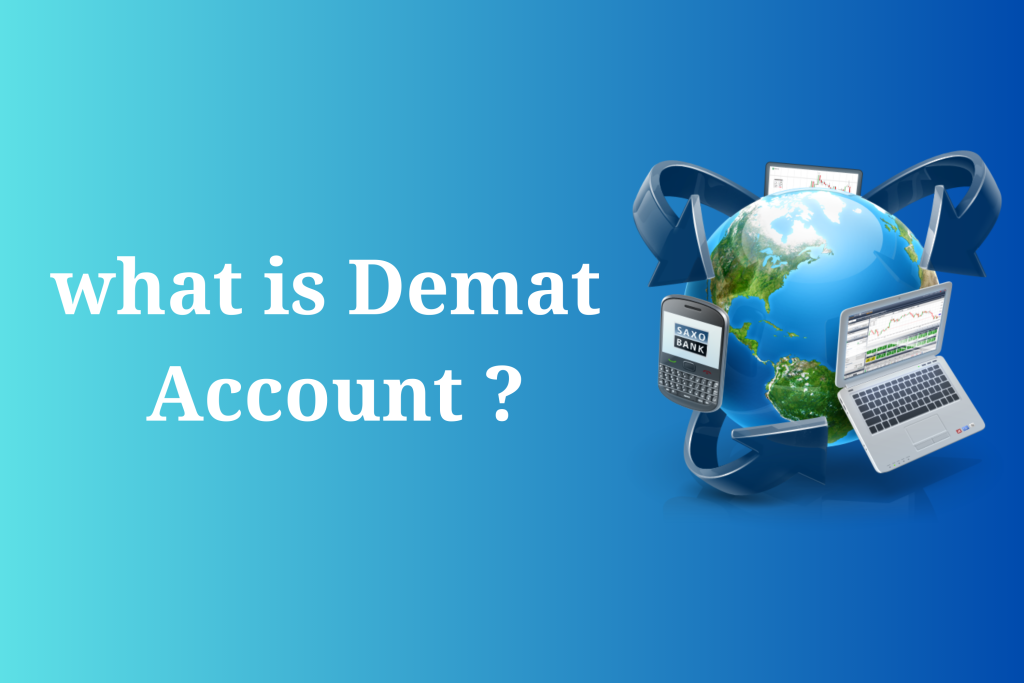What is Demat Account?
In India, a Demat account, short for dematerialized account, is a digital depository where an individual or investor can hold and manage their securities in electronic form. It is a way to eliminate the need for physical share certificates and offers a convenient way to trade and invest in various financial instruments without handling paper documents.
- Electronic Holding: A demat account allows you to hold various financial instruments like stocks, bonds, debentures, mutual funds, exchange traded funds (ETFs), government securities and many more in electronic form. It converts physical securities into digital form, making them easier to manage and trade.
- Trading and Investment: The main purpose of a Demat account is to facilitate trading and investment activities. When you buy shares or other securities, they are credited to your Demat account and when you sell, they are debited from the account.
- Maintenance: Demat accounts provide a safe way of holding securities. Physical certificates can be lost, damaged or stolen, but custodial participants protect and safeguard electronic property against such risks.
- Ease of Transfer: Transfer of securities from one Demat account to another is a simple process that often involves an electronic transfer mechanism that reduces paperwork and time.
- Paperless Transactions: Demat accounts facilitate paperless transactions, making the process of buying, selling and transferring securities more efficient. This is in line with the wider goal of digitization and reduction of administrative burden.
- Convenience: Investors can track their holdings online, view transaction history and receive account statements electronically. This convenience helps you monitor your investments and make informed decisions.
- Corporate Transactions: Corporate transactions such as dividends, bonuses, subscription rights etc. are automatically credited to the Demat account. This eliminates the need for investors to physically present share certificates to receive these benefits.
- Risk Elimination: Risks associated with physical securities such as forgery, theft and loss are greatly reduced with the help of Demat accounts. Linkage with trading account: While securities are held in a Demat account, a separate trading account is usually required to place buy and sell orders for these securities in the stock market.
Depositories like the National Securities Depository Limited (NSDL) and the Central Depository Services (India) Limited (CDSL) are responsible for maintaining Demat accounts in India. To open a Demat account, individuals need to approach a Depository Participant (DP), which could be a bank, a financial institution, or a brokerage firm that is registered with the depositories.
It’s important to note that while Demat accounts provide numerous advantages, investors should also be aware of associated charges such as account opening fees, annual maintenance charges, and transaction fees.
Step by step guide to how to open a demat account?
- Choose a Depository (DP): The first step is to choose a depository, which is basically a financial institution that acts as an intermediary between you and the depository institution (NSDL or CDSL). Many banks and bankers offer DP services. Some popular ones are HDFC Bank, ICICI Bank, Kotak Securities etc.
- Application form: Get the selected DP account opening form. You can usually find this form on their website or by visiting their office. You can also request that it be sent to you by post.
- Fill the Form: Fill out the application form with accurate and up-to-date information. This form will require personal details like name, address, PAN number, date of birth, occupation, etc.
- KYC Process: You will have to go through the KYC (Know Your Customer) process. This involves in-person verification at the DP’s office or through video call verification, depending on the DP’s policies.
- Aadhaar-based e-Sign: Some DPs offer Aadhaar-based e-Sign, allowing you to electronically sign your application form using your Aadhaar credentials.
- Agreements and Disclosures: Read and understand the agreements, terms, and conditions provided by the DP. Ensure you are comfortable with the fee structure and other policies.
- In-Person Visit: If an in-person visit is required, visit the DP’s branch office with the completed application form and all necessary documents. A representative will guide you through the process and help you complete any pending formalities.
- Verification and Approval: Your application will be verified by the DP and then sent to the depository for final approval. This process usually takes a few days to a couple of weeks.
- Account Details: Once your application is approved, you will receive your Demat account details, including your Demat account number. This will be necessary for future transactions.
- Trading Account (Optional): While a Demat account holds your securities, you will need a trading account to buy and sell stocks. Some DPs provide integrated Demat and trading accounts, while others might require you to separately open a trading account with them or another broker.
- Supporting Documents: Along with the application form, you’ll need to provide some supporting documents:
- Proof of Identity (PoI): This can be your Aadhaar card, passport, driver’s license, voter ID, etc.
- Proof of Address (PoA): Documents like Aadhaar card, passport, utility bills, bank statements, etc., can be used.
- PAN card copy: A copy of your Permanent Account Number card is essential.
- Passport-sized photographs: Attach a few recent passport-sized photographs as per the requirement.
Today many financial institutions and brokerage firms in India like Angel broking, Zerodha, Upstox offer the facility to open a Demat account online. However, the specific process and requirements have changed now a days. Here’s a general outline of how you could open an online Demat account in India:






- Choose a Depository Participant (DP)
- Visit the DP’s Website
- Fill the Online Application Form
- Upload Documents
- E-Signature or In-Person Verification
- Video KYC
- Wait for Approval
- Receive Account Details
- Access Online Platform
- Start Trading and Investing
Opening a Demat account in India involves certain fees, such as account opening charges, annual maintenance charges, and transaction charges. It’s recommended to carefully understand the fee structure and terms before proceeding. Before investing in the stock market it is advised you to get complete knowledge about stock market like fundamental and technical analysis because it involves a greater risk.

